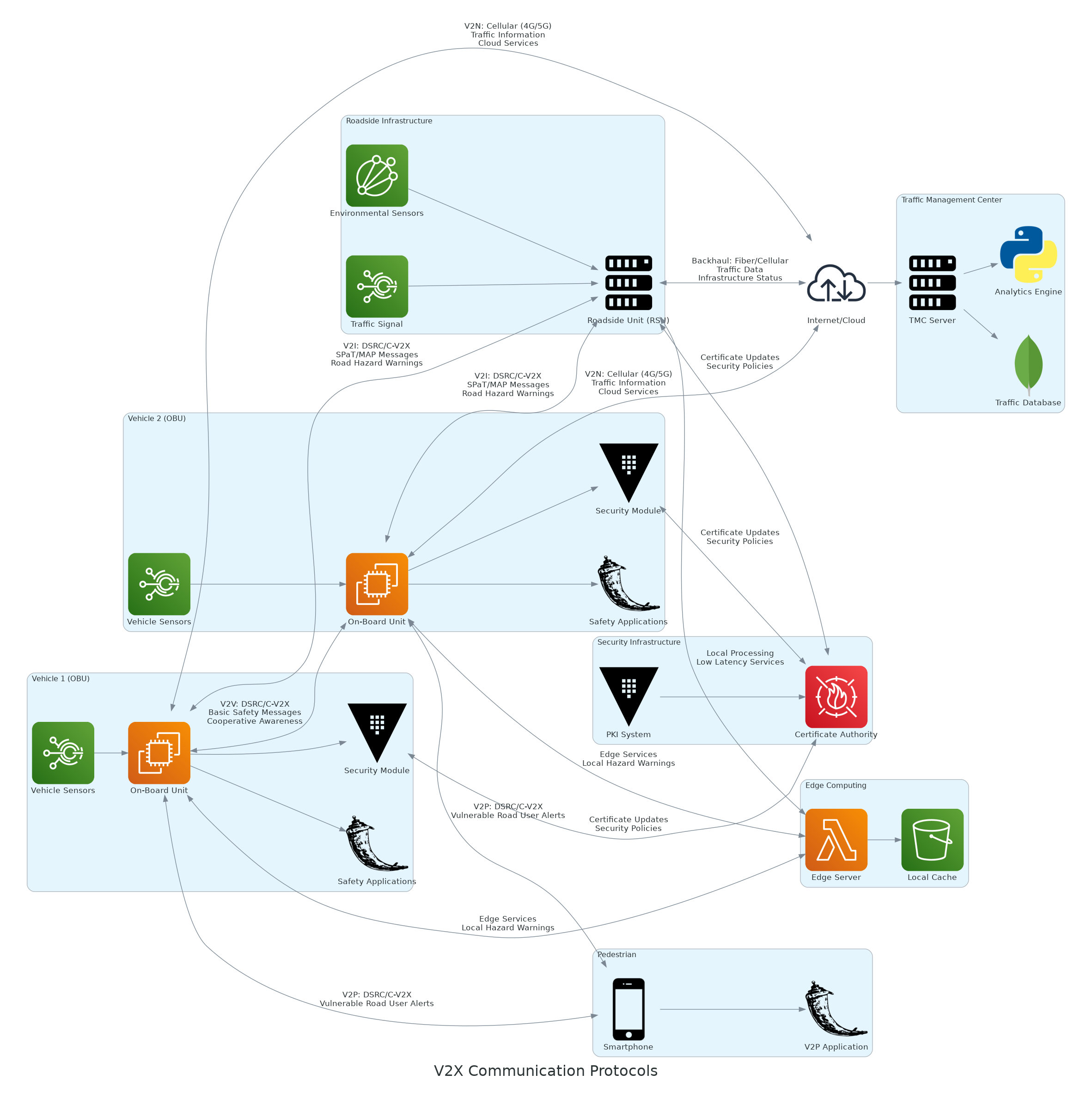V2X Communication Protocols Diagram

V2V Communication (DSRC/C-V2X Direct)
Vehicle-to-Vehicle communication enables direct exchange of information between vehicles using either DSRC or C-V2X technology. This communication mode is critical for safety applications as it allows vehicles to share their position, speed, and direction with nearby vehicles, enabling early detection of potential collision scenarios.
Key Protocols:
- Basic Safety Messages (BSM): Contain vehicle status information
- Cooperative Awareness Messages (CAM): Provide real-time vehicle awareness
- Decentralized Environmental Notification Messages (DENM): Alert about road hazards
Applications:
- Forward Collision Warning
- Emergency Brake Warning
- Blind Spot Warning
- Lane Change Warning
- Cooperative Adaptive Cruise Control
V2I Communication (DSRC/C-V2X)
Vehicle-to-Infrastructure communication connects vehicles with roadside infrastructure such as traffic signals, road signs, and roadside units. This enables vehicles to receive information about traffic conditions, signal timing, and road hazards that may not be directly visible to the driver.
Key Protocols:
- Signal Phase and Timing (SPaT): Provide traffic signal information
- Map Data (MAP): Describe intersection geometry
- Road Side Alert (RSA): Warn about road hazards
Applications:
- Traffic Signal Phase and Timing (SPaT)
- Green Light Optimal Speed Advisory (GLOSA)
- Road Work Warning
- Hazardous Location Notification
- Electronic Toll Collection
V2P Communication (DSRC/C-V2X)
Vehicle-to-Pedestrian communication enables vehicles to detect and communicate with vulnerable road users such as pedestrians, cyclists, and motorcyclists. This is typically achieved through smartphones or wearable devices that can communicate with vehicles using V2X technology.
Key Protocols:
- Personal Safety Messages (PSM): Contain pedestrian location and movement
- Vulnerable Road User Alerts: Warn drivers about nearby pedestrians
Applications:
- Pedestrian Detection and Warning
- Crosswalk Warning
- School Zone Notification
- Vulnerable Road User Protection
V2N Communication (Cellular)
Vehicle-to-Network communication uses cellular networks (4G/5G) to connect vehicles with cloud-based services and applications. This enables access to a wide range of services beyond the immediate vicinity of the vehicle, such as real-time traffic information, weather updates, and infotainment services.
Key Protocols:
- HTTP/HTTPS: Standard web protocols
- MQTT: Lightweight messaging protocol for IoT
- TCP/IP: Fundamental internet protocols
Applications:
- Dynamic Routing
- Real-time Traffic Information
- Weather Updates
- Over-the-air Software Updates
- Infotainment Services
Security Communication
Security communication ensures the authenticity, integrity, and confidentiality of V2X messages. This includes certificate management, authentication, and encryption to protect against various security threats.
Key Protocols:
- IEEE 1609.2: Security services for V2X
- SCMS: Security Credential Management System
- PKI: Public Key Infrastructure
Applications:
- Certificate Updates
- Security Policies
- Misbehavior Detection
- Privacy Protection
Edge Computing Communication
Edge computing communication enables low-latency processing of V2X data by bringing computation closer to the data source. This is particularly important for safety-critical applications that require real-time response.
Key Protocols:
- Local Processing Protocols
- Edge Service Discovery
- Local Hazard Warnings
Applications:
- Local Hazard Detection
- Real-time Traffic Analysis
- Cooperative Perception
- Intersection Management
Backhaul Communication
Backhaul communication connects roadside infrastructure with traffic management centers and other backend systems. This enables centralized monitoring, management, and coordination of the V2X system.
Key Protocols:
- Fiber/Ethernet: High-bandwidth wired communication
- Cellular (4G/5G): Wireless backhaul
- VPN: Secure communication tunnels
Applications:
- Traffic Data Collection
- Infrastructure Status Monitoring
- System Management
- Software Updates